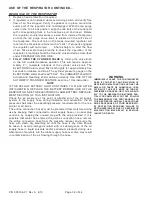
Page 36 of 44
P/N 595189-01 Rev A 4/10
WArning
The uSer of ThiS reSPirATor mAy hAve
To diSconnecT The hoSe couPling
Suddenly And under STreSSful con-
diTionS. The uSer muST be Able To diS-
connecT The couPling under The con-
diTionS Which mAy be encounTered
during uSe, for exAmPle, WiThouT be-
ing Able To See The couPling, WiTh
gloveS on, WiTh one hAnd, eTc. fAil-
ure To AdeQuATely TrAin The uSer mAy
reSulT in SeriouS inJury or deATh.
WArning
reSPirATorS uSed for emergency eS-
cAPe muST be Thoroughly inSPecTed
And rechArged before reTurning
To Service. fAilure To inSPecT The
reSPirATor And rechArge The Self-
conTAined Air SuPPly cylinder mAy
reSulT in A mAlfuncTion of The reS-
PirATor Which could cAuSe SeriouS
inJury or deATh.
WArning
emergency SiTuATionS Tend To increASe
breAThing rATe And, Therefore, To de-
creASe The AcTuAl durATion of The
Self-conTAined Air SuPPly. fAilure To
TAKe Such fAcTorS inTo AccounT When
uSing The reSPirATor for eScAPe mAy
reSulT in Sudden TerminATion of
breAThing Air Which could cAuSe
SeriouS inJury or deATh.
WArning
The vAlve on The Self-conTAined Air
SuPPly cylinder muST be fully oPen
for ProPer oPerATion of The AuTo-
mATic TrAnSfer feATure. See The uSe
of AuTomATic TrAnSfer feATure Sec-
Tion of ThiS inSTrucTion. fAilure To
underSTAnd The oPerATion of ThiS
eQuiPmenT mAy reSulT in SeriouS in-
Jury or deATh.
WArning
if eiTher The vibrAlerT end of Ser-
vice Time indicATor or The elecTronic
AlArm AcTuATeS AT Any Time during
reSPirATor uSe, leAve The AreA re-
Quiring reSPirATory ProTecTion imme-
diATely. AcTuATion of The vibrAlerT
meAnS ThAT The Air SuPPly hoSe hAS
fAiled And iS no longer Providing The
neceSSAry PreSSure To oPerATe The
reSPirATor. AcTuATion of The elec-
Tronic AlArm meAnS ThAT The Air SuP-
Ply cylinder hAS been dePleTed To
90% (+/-5%) of full volume. in eiTher
cASe, fAilure To leAve The hAZArd-
ouS AreA immediATely mAy reSulT in
SeriouS inJury or deATh.
emergency uSe Procedure
IF CONDITIONS IN THE WORKPLACE REQUIRE EMERGENCY
EVACUATION during respirator use, the preferred procedure is to
egress with respirator connected to the air supply hose following the
path taken during entry into the workplace. If it becomes necessary
to disconnect the respirator from the air supply hose for egress—for
instance, if the hose is entangled or if it is necessary to exit by a
different route—the user shall disconnect the hose and immediately
leave the area requiring respiratory protection. The VIBRALERT end of
service time indicator alarm shall actuate indicating that the respirator
user is now breathing from the air supply cylinder. The ELECTRONIC
alarm RED light shall actuate when the air supply in the cylinder has
dropped below 90% (+/-5%) of "FULL".
IF EITHER THE VIBRALERT END OF SERVICE TIME INDICATOR
OR THE ELECTRONIC ALARM ACTUATES AT ANY TIME DURING
RESPIRATOR USE, leave the area requiring respiratory protection im-
mediately. Actuation of the VIBRALERT means that the air supply has
been interrupted and is no longer providing the necessary pressure
to operate the respirator. Actuation of the ELECTRONIC alarm RED
light means that the air supply cylinder has been depleted to
90% (+/-5%) of full volume. Actuation of the ELECTRONIC alarm
LOW BATTERY YELLOW light means the battery must be changed.
In any case, the user must leave the hazardous area immediately.
noTe
THE SKA-PAK AT COMBINATION SCBA AND TYPE C RESPIRA-
TOR IS A PRESSURE DEMAND OPEN CIRCUIT TYPE BREATHING
APPARATUS. DURING USE, AIR SHALL FLOW FREELY INTO THE
FACEPIECE DURING INHALATION ONLY, AND AIR SHALL CEASE
FLOWING AT ALL OTHER TIMES. IF AIR CONTINUES TO FLOW
FROM THE BREATHING REGULATOR AFTER INHALATION CEASES,
THE PURGE VALVE (RED KNOB ON REGULATOR) MAY BE OPEN
OR THE FACEPIECE MAY NOT BE SEALING AGAINST THE FACE.
IF ExCESS AIR FLOW IS NOTICED DURING ESCAPE, CHECK THAT
THE PURGE VALVE IS CLOSED (ROTATED FULL CLOCKWISE WITH
POINTER ON KNOB UPWARD) AND THAT THE FACEPIECE HAS
BEEN DONNED PROPERLY AND TIGHTENED PROPERLY WHILE
CONTINUING YOUR ESCAPE.
1.
breAThe
normally. When breathing from the air supply cylinder,
the VIBRALERT end of service time indicator shall continue to
actuate.
2.
diSconnecT
the air supply hose from the airline connection
hose, if necessary.
3.
egreSS
to an area with a safe, breathable atmosphere follow-
ing all precautions and procedures of your respiratory protection
program.
4. When in a safe breathing atmosphere, doff the facepiece accord-
ing to the instructions under TERMINATION OF USE.
5. Close the cylinder valve by pushing in and rotating the cylinder
valve knob full clockwise.
6. Remove the respirator from service and tag for charging, inspec-
tion and cleaning.
uSe of The reSPirATor conTinued...




































